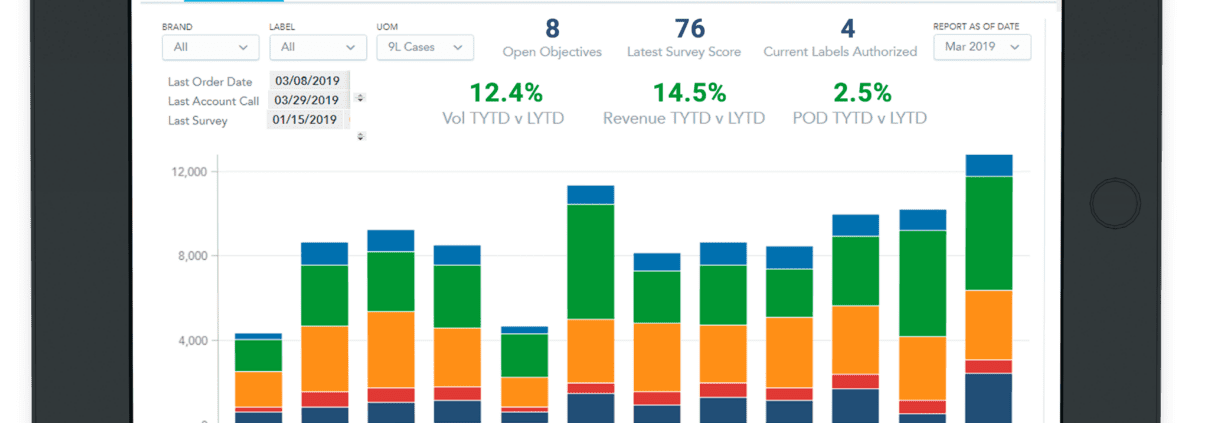How Embedded Analytics Drives Improved Sales Execution
In the hyper competitive world of beverage alcohol sales, organizations must leverage technology to enable their sales and trade marketing resources to be intelligently productive, or risk being out executed by their competition at retail, on-premise and national accounts alike.
Far too many great brands are not realizing their fair share of the trade sales prize because their sales teams are playing the game without a robust sales execution solution to help them win. Most organizations use a mix of “single use case” apps, spreadsheets and disparate reporting tools to piece together their toolkit, limiting users ability to work mobile and requiring extra clicks and data jockeying without a synergize workflow. This is due to the fact that putting everything in one place is very hard to do, especially without leveraging the latest solutions available.
Perhaps the biggest gap in delivering a valuable solution for sales people is the lack of real-time embedded analytics integrating both sales and execution data directly in a user-friendly mobile application. The value of having comprehensive analytics embedded in a sales execution solution can be measured not only by the level of productivity of field sales people, but by the strategic precision with which they execute. Those without this advantage are slower to market, miss more opportunities, act less strategically and waste more time.
The Aberdeen Group recently collaborated with GoodData, a BI tool specializing in embedded analytics, to produce a compelling survey and report titled “Driving Toward Analytical Ubiquity With Embedded Analytics”. The aim of this survey was to explore how bridging the gaps between data, information and results can help to generate more meaningful insights for organizations of all sizes, and how successful businesses are moving analytics from an IT function to non-technical users by embedding analytics into apps that empower the workforce.
While many companies “have” the data, few are able to do anything constructive with it, and even fewer actually leverage it quickly to impact their business. One reason is because different data sources are often not integrated into a single analytics solution. Users have to go to different apps and reports for different things, and one data set cannot be leveraged against another to glean insights.
Imagine having a strategy of securing menu features for a specific product in specific types of accounts, without the ability to easily execute against it. Perhaps the sales team does have all of the data they need to execute this program, but rarely is it all in one place where sales people can take action on it in a precise, efficient and productive manner. Even if you properly identify the target accounts without an existing menu, the act of tracking the menu and comparing product sales is often a complex exercise in spreadsheet wizardry. Menu programs may be a sound strategy and KPI, but most sales teams cannot execute them well because of the data analytical skills which we all know is not the strong suit of a great salesperson (nor should it be).


In this example, with the right solution, sales people would be able to filter their accounts by segment while examining sales data, survey results and executional CRM data on their mobile device to identify the right accounts to target. They can then set objectives to accomplish the menu, create calendar appointments for each account, and immediately view results against the program by account, as they are walking in the door. Quite a contrast versus the sales team still working on Excel spreadsheets all day.
Most business software has some basic reporting capability and some companies rely on this to do the job, but integrating the data from all sources and systems and analyzing it all together is much more powerful. Simply viewing survey results in an app without the related sales data, buyer name and phone number is just not actionable and not delivering real value to the sales people in the field, nor the marketing team and executives looking to analyze the sales effectiveness of programs being executed.
Having integrated data and analytics embedded in a sales execution solution enables organizations to execute on their strategic KPIs with precision and speed.
Technology is always changing, and the more modern sales teams must adapt. In their study, The Aberdeen Group points out “the first wave of BI was IT controlled and lacked business context. The second wave used analysts to manipulate and compute the data to discover an insight. Now, modern BI puts the analytics in front of the end user in context with their business”.
In the study, the most important factors companies stated for implementing an embedded BI solution for end users was:
- Ease of Use
- Ease of integration
- Efficient to deploy
- Multiple data sources
- Speed of data to market
The study found that companies see “close to 30% more usage and engagement in the [business intelligence] when embedded”. They also found that companies with an embedded BI approach had capabilities that far exceeded those with a stand alone BI solution, with multiple improvements are found in:
- Getting people focused on the right things
- More simple and easy to use
- Evolves faster through end user input
The Aberdeen Group concludes that “Companies need to build an analytically engaged workforce if they are to be successful.” Additionally, “It is important not only to embed in applications for easy access and intel, but also leverage with key internal processes” like goal management, CRM and executing key account activity.

By having embedded analytics companies see much faster sales cycles than those that used outdated siloed BI solutions. “They outpace competition when it comes to growth, cross selling and up-selling and higher profit margins.” Sales Managers have better insight into what’s driving their business and marketing can analyze ROI and the value/success of their efforts. Lastly, executives can have oversight into performance at a granular level at their fingertips.
Don’t just deploy one off apps or solutions to manage important sales execution strategies. To optimize your sales team and resources, get a comprehensive sales execution solution that integrates data and embeds analytics all in one place. In this competitive marketplace, organizations need all the help they can get to win. This is something proven that can be done today with GreatVines.

